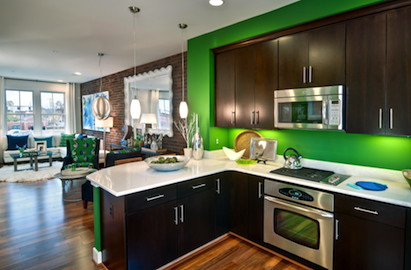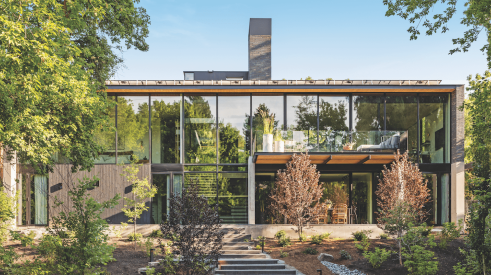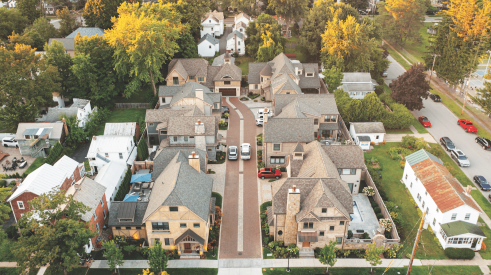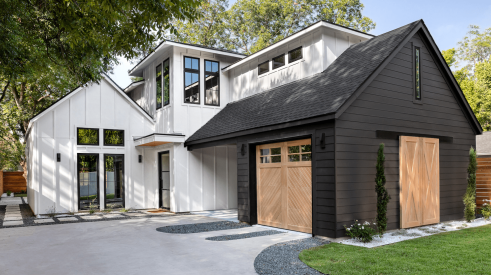Infill development, particularly on smaller sites, has grown in popularity as large-scale development dwindles. But over the last 10 to 15 years, a number of factors have brought about changes in infill housing, including buyer preferences, site constraints, zoning and parking issues, and the economy.
“When the housing market was red-hot there seemed to be a perception that anything infill would work,” says Robert Youngentob, president of EYA, a home builder that specializes in infill development in the Washington, D.C., metropolitan area. “People were taking more chances with more fringe areas. Then, as the recession came and the market dramatically weakened, a lot of those fringe areas became less marketable. So builders and developers have refocused on infill locations close to existing retail or public transportation.”
5 Trends in infill housing
|
|
Over the course of 12 years, Youngentob says, young professionals who used to buy homes in the city, then move out to the suburbs once they’d had children, have lost their taste for suburban living. Once settled in an infill community, they’re much more likely to raise a family there because it’s close to mass transit, shopping, dining, and other amenities.
Some of the nation’s most successful builders and designers clued us in about the changes in infill housing design that have taken place since the market went from hot to frigid.
Smaller sites in odd shapes
Infill projects have gotten smaller partly because the sites are smaller. That’s mostly due to the recession, says architect Richard Handlen, senior vice president and principal of EDI International, Larkspur, Calif. “Expectations are smaller,” Handlen says. “Then there’s the green movement. The greenest thing you can do is build as small as possible, because it saves materials and gives you the most bang for the buck.”
The shape and size of the parcel, and what surrounds it, influences the kind of product that can be built there. “For example, we can’t really put three-story townhomes next to one-story, single-family homes that were built in the 1950s,” says David Barisic, vice president of sales and marketing for Brandywine Homes in Irvine, Calif. “It just doesn’t work. We also can’t put large-estate lots on the site of a redeveloped strip mall that’s 1,000 feet long but only 100 feet deep.”
Faced with smaller and often irregularly shaped sites, builders and architects have had to get creative. Century Village, a community that Brandywine is building in Garden Grove, Calif., occupies a site that is triangular at one end. That presented an opportunity for architect KTGY Group of Irvine, Calif. “We were able to create a very unique unit that would sit right at the corner of our two cross streets,” says KTGY’s Bryan Sevy. “We custom-designed the home to fit that shape.”
Sevy adds, “It almost seems like any infill site is a good site if it’s in a good area, no matter how small or oddly shaped. We’re dealing more and more with sites that have what previously might have been considered incompatible adjacencies next to industrial uses, such as auto-body shops.”
Where do we park?
Let’s face it: Home buyers aren’t giving up their cars. But in certain infill locations, especially those near public transportation, parking is less of an issue.
“While we always feel that at least two parking spaces per unit are required for a townhouse, more and more of our buyers will accept one parking space as long as there’s some level of guest parking on the street,” Youngentob says.
Barisic says that when the housing market was hot, Brandywine eliminated driveways on some constrained sites in order to achieve higher densities. The builder compensated by providing designated parking areas, but the lack of driveways created a huge parking issue.
Brandywine has since abandoned that approach. At Century Village, the company is building three-story townhomes with two- and three-car garages, plus on-site guest parking. Garages are accessed by rear alleyways and will not be visible from the street, says Sevy.
“We used to do a lot of townhomes with a high number of tandem garage spaces, where you have one car parked in front of another,” says Sevy. “In some markets we’ll still do tandem, primarily in the San Francisco Bay area. But in most places there’s been a lot of resistance from cities on tandem parking, and the market seems less willing to accept it.”
While on-grade or subterranean garages inside buildings have worked for some infill sites, Sevy says that nowadays there’s not as much demand for structured parking. “The cost is so high it’s not feasible in a lot of these small projects. Plus, the site is often too small to efficiently lay out a structured parking garage.”
Don't go too high or narrow
When Naval Square in Center City Philadelphia opened for sales in 2005, one of the product lines offered by Toll Brothers was a four-story townhome. These sold well for the first two years, but toward the end of 2006 “sales suddenly dropped off,” says Chuck Breder, Toll’s division senior vice president in charge of Naval Square. “Now our more-popular townhome model is a stacked, two-story unit, to the point where we took home sites that had been earmarked for four-story units and ripped the foundations out.”
Brandywine’s Barisic finds that “the communities we’re building these days almost have reverted back in type to what we were building 10 or 15 years ago.”
In the mid-2000s, rising land and home prices forced Brandywine to come up with innovative designs for single-family homes. “We were building three-story designs, zero-lot-line configurations, and detached condos to maximize density and keep the pricing at an affordable level,” says Barisic. “But today we’re trying to provide more traditional single-family homes with bigger yards and driveways.” Brandywine also builds two- and three-story townhomes, but has gotten away from stacked condominiums and podium-style buildings, Barisic says.
“We tried to go with more and more narrow, three-story townhomes,” says Michael Maples, principal and CEO of Trumark Homes, Danville, Calif. “We were pushing those units down to 16 feet wide at one point, and that worked in a hot market, but now it’s not acceptable. It needs to be wide enough to read well on the living spaces.”
Maples also says buyers are more willing to accept smaller usable yard space than they were 10 years ago. “A private back yard is preferable to a big porch, as long as it’s functional,” he says.
Detached homes get smaller
Detached housing is always going to be a hot button, says Handlen, “because no one likes to have a neighbor attached.” With detached infill, of course, comes higher density. EDI’s Willow Road project, a collection of detached homes in Menlo Park, Calif., is often mistaken for multi-family housing because the units are so close together (density is 13.5 dwelling units per acre).
“In Orange County, even in projects we would consider infill, a lot of people still prefer a detached property,” says Trumark’s Maples. “They will pay a premium for it, but the lot doesn’t have to be huge.”
Brandywine is building smaller detached homes because they’re more affordable. “We try to keep them between 1,400 and 2,300 square feet, instead of the 2,200- to 2,600-square-foot homes we used to build,” says Barisic.
Nevertheless, attached seems to be the predominant housing type on infill sites. About 98 percent of EYA’s product is townhomes. “We’ve done a couple of projects with detached product, but normally it’s attached,” says Youngentob. “There’s always going to be pressure on land values and therefore, density is important.”
Advertisement
Related Stories
Design
2023 BALA Winners: The Best of the Best
You'll find plenty of inspiration in these four award-winning projects from the Best in American Living Awards
Design
A Smart Single-Family Infill Development Recalls Traditional European Charm and Detail
A compact infill lot transformed into a community of seven luxury single-family homes serves as a model for smart land use and engaging design
Design
From Infill Lot to Urban Oasis: Home Design That Maximizes a Compact Site
Elevated creativity makes the most of a tiny tree-filled lot to create a light-filled, modern farmhouse in this award-winning design in Austin







